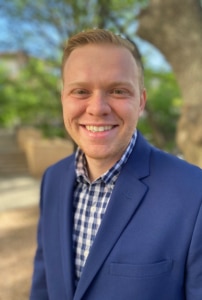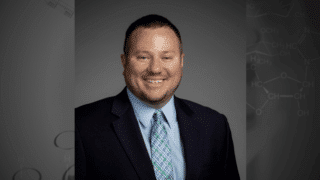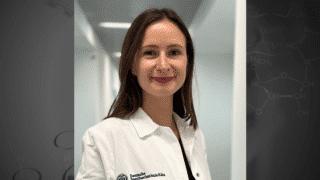 The PCC was pleased to partner with the American Physiological Society (APS) this year to support two talented trainees through the PCC-sponsored Anti-doping Predoctoral Awards! These awards recognize one or more predoctoral graduate students for their outstanding research in environmental, exercise, thermal, or applied physiology. Awardees must be conducting research relevant to ergogenics, the detection of performance-enhancing drugs and procedures, and/or the impact of training and environmental stresses on hematological profiles. Frank Wojan is a Ph.D. student at The University of Texas at Austin whose current research focuses on the erythropoietic effects of intermittent hypoxia in patients with type 2 diabetes. Learn more about Frank and his research in our interview below.
The PCC was pleased to partner with the American Physiological Society (APS) this year to support two talented trainees through the PCC-sponsored Anti-doping Predoctoral Awards! These awards recognize one or more predoctoral graduate students for their outstanding research in environmental, exercise, thermal, or applied physiology. Awardees must be conducting research relevant to ergogenics, the detection of performance-enhancing drugs and procedures, and/or the impact of training and environmental stresses on hematological profiles. Frank Wojan is a Ph.D. student at The University of Texas at Austin whose current research focuses on the erythropoietic effects of intermittent hypoxia in patients with type 2 diabetes. Learn more about Frank and his research in our interview below.
Background
Tell us about your educational background.
I recently completed my doctoral degree in exercise physiology within the Clinical Exercise Physiology Laboratory at The University of Texas at Austin (UT Austin). Prior to my time at UT Austin, I had experience as a Clinical Project Manager for Exercising Nutritionally, LLC (EN LLC; Lisle, IL) investigating the ergogenic effects of several nutraceuticals for sports performance and clinical populations alike. Along with my role at EN, LLC, I was able to complete my master’s degree at Northern Illinois University where my interest was sparked for my future learning and career. Specifically, my advisors, who later became my employers at EN, LLC, saw the raw potential I had exhibited as a Pre-PT undergrad and developed me into the researcher I am today. Moreover, they guided my master’s thesis and initiated my interest in hypoxia investigating the acute cardiovascular and metabolic effects of altitude and/or supplemental oxygen recovery during high intensity interval training (HIIT) intervals into the foundation for my future research at UT Austin.
What educational/professional opportunities helped you reach this point in your career?
Reflecting on my path to where I am today, great mentors and advisors were critical. These individuals in my life always had my long-term interests in mind, even when these interests were not yet known to me at the time. Specifically, having individuals you can lean on that have been where you are at some point allows you to walk in their shoes until you can step out of them. For example, my mentor Dr. Craig Broeder, FACSM, FNASSO, who is known for his impressive presentations and public speaking, was great for me to have in my corner, and he allowed me to develop my own skills coinciding with my first public speaking event at the American College of Sports Medicine national conference in Minneapolis. From this experience and many others since, I really have come to the conclusion that being a great public speaker can take your career so much further. The best advice I can give similar individuals is to simply put yourself in as many opportunities as possible to build your comfort and confidence. In addition to that, you’re the expert! No one should know the topic as well as you — lean into that!
Research
What do you find most interesting or exciting about your research area?
While at UT Austin, I was responsible for creating a novel hypoxic (altitude) protocol, defined as intermittent hypoxia. For example, this intermittent approach is symbolic of a quick elevator ride to the top of Pike’s Peak, staying for 4 minutes, and returning to sea level afterward. This process repeated for a period of eight “rides” over a period of hour (Wojan 2021). Specifically, I was interested in the erythropoietic outcomes from this short exposure and subsequently integrated it into populations of older adults and patients with type 2 diabetes (Wojan 2023). While my work did not focus on the sports performance aspect of this, I believe there could be some great benefit to athletes, while limiting the deleterious effects of prolonged altitude exposure, or it could even be a more applicable approach that boosts performance similar to the Live-high-train-low paradigm that’s been popularized as a training methodology for athletes competing at altitude. What excites me most about this hypoxic approach is the cross-protective benefits that intermittent hypoxia may offer. Since hypoxia is a systemic environmental stressor, individuals may experience improvements in cardiovascular function, cerebral oxygenation, cognition, and metabolic control.
You recently presented a poster at the 2023 American Physiology Summit. Can you describe the findings of your work so far?
Keeping in the theme of this short intermittent hypoxia approach, we wanted to investigate the effects in a population that may suffer from lower levels of red blood cells; patients with type 2 diabetes. A critical finding from my work was that individuals with type 2 diabetes and normal renal function exhibited an impaired erythropoietin (EPO) response. (EPO is the main hormone that regulates the maturation and creation of red blood cells.) Of note, the same hypoxic protocol had increased EPO levels by 65% and 31% in young and older individuals, respectively. Finally, my work is the first to report levels of hemoglobin mass (a marker that represents the capacity of the body to carry oxygen in red blood cells) in patients with type 2 diabetes and demonstrates that this population experiences roughly a 20% decline when matched to similarly aged non-diabetic individuals.
What are the impacts or potential impacts of your research?
Coinciding with a ~20% decline in hemoglobin mass in patients with type 2 diabetes is a similar decline in maximal oxygen consumption. While this metric is critical among athletes as a measure for fitness level, it corresponds very well with cardiovascular disease risk and mortality. While normal physical activity can improve maximal oxygen consumption, only 33% of patients with type 2 diabetes meet recommended physical activity guidelines. As such, innovative approaches that may improve maximal oxygen consumption and hemoglobin mass, while limiting physical activity, may improve the health and longevity of chronic disease populations, which currently represent a significant portion of the adult American population over 40 years of age. While it remains unreported as to what effects this protocol may have in athlete populations, if repeated for a few days of the week, it may have great potential to improve endurance performance and competition outcomes.
Goals and PCC Benefits
How did you learn about the American Physiological Society?
I have been aware of APS for around 4 years while at UT Austin. The annual APS meeting is the main conference our lab attends, due to similar investigative approaches and scientific rigor.
How did you learn about the Environmental & Exercise Physiology (EEP) Section Partnership for Clean Competition Anti-Doping Research Award?
While seeking out opportunities to present my work, I found the EEP section’s Partnership for Clean Competition Anti-Doping Research Award online. Although my work centers on the clinical implications for populations such as patients with type 2 diabetes, the performance effects from such protocols are also relevant for athlete populations seeking improvement. It’s critical to understand what athletes may be incorporating into training, especially if it can alter performance.
How will the Environmental & Exercise Physiology Section Partnership for Clean Competition Anti-Doping Research Award contribute to your success?
I’m so very thankful to have been awarded one of the Predoctoral Awards sponsored by the PCC. It has given me an opportunity present my work publicly, gain recognition, and increase awareness of my research. Attending this year’s APS meeting was a valuable opportunity to improve my public speaking, network with likeminded individuals, and learn about innovative research being conducted.
What parallels do you see between Exercise Physiology and the work being done in the Anti-Doping field?
I think both realms need to continue working together to understand physiology and potential therapeutic targets/strategies. Athletes will always be ahead of the curve due to their desire to win, but we as an Exercise Physiology discipline serve the role of catching up to them and weeding out possible drugs, therapeutics, or training modalities that may or may not provide an advantage. I view the PCC as an advocate for us to help level the playing field for competitive sport. We as a discipline are incredibly thankful for such support and interest in our work.
What are your long-term research or career goals?
I am still a bit undecided as to where my career is headed, but I wish to remain part of the research world. I would love the opportunity to continue my work and investigate the aforementioned performance-boosting outcomes from intermittent hypoxia. No matter the field, research, or place in my career, I aim to make good use of the qualities I have developed and skills I have learned from my many years of research and outstanding mentors.



